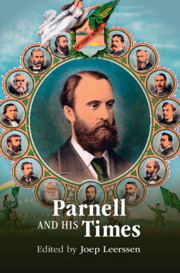Book contents
- Parnell and His Times
- Frontispiece
- Parnell and His Times
- Copyright page
- Dedication
- Contents
- Illustrations
- Contributors
- Acknowledgement
- Introduction
- Part I Parnell’s Ireland and Its Different Temporalities
- Chapter 1 O’Connell and Parnell
- Chapter 2 The Paradoxes of Parnell
- Chapter 3 Parnell to Pearse
- Chapter 4 Race, Nation, State
- Chapter 5 Parnell’s Other Ireland
- Chapter 6 Inside History
- Chapter 7 Digesting the Past
- Chapter 8 The Writing of County Histories in Parnell’s Ireland
- Part II After Parnell
- Index
Chapter 3 - Parnell to Pearse
from Part I - Parnell’s Ireland and Its Different Temporalities
Published online by Cambridge University Press: 03 December 2020
- Parnell and His Times
- Frontispiece
- Parnell and His Times
- Copyright page
- Dedication
- Contents
- Illustrations
- Contributors
- Acknowledgement
- Introduction
- Part I Parnell’s Ireland and Its Different Temporalities
- Chapter 1 O’Connell and Parnell
- Chapter 2 The Paradoxes of Parnell
- Chapter 3 Parnell to Pearse
- Chapter 4 Race, Nation, State
- Chapter 5 Parnell’s Other Ireland
- Chapter 6 Inside History
- Chapter 7 Digesting the Past
- Chapter 8 The Writing of County Histories in Parnell’s Ireland
- Part II After Parnell
- Index
Summary
The transition from Parnell’s domination of Irish politics to the development and aftermath of the Irish revolution has been variously interpreted by influential mythographers, notably W. B. Yeats and Patrick Pearse. This essay takes a different angle, querying Conor Cruise O’Brien’s celebrated statement that Parnell ‘deviated into literature’, emphasizing the shifts of influence towards the agency of women’s political organizations, reasserting the importance of the conservative underpinning provided by the revolution in landownership, and questioning the influential but misplaced emphasis on Parnell’s supposed latter-day Fenian sympathies. Concerning the eventual outcome of the revolution, and the kind of Ireland that emerged, the result of the Treaty might be seen not only as consistent with Arthur Griffith’s long-term aims, but squarely in line with the kind of Home Rule Ireland outlined by Parnell to a confidant forty years before: ‘a small-c conservative government, backed by the Irish democracy and peasant proprietary, linked to the Empire by Crown and an imperial contribution, and with enough economic autonomy to protect and encourage Irish industries’. This was a far cry from the ideal nurtured by Pearse and many of the revolutionary generation, but it buttresses Parnell’s claim to be considered a maker of modern Ireland.
- Type
- Chapter
- Information
- Parnell and his Times , pp. 53 - 69Publisher: Cambridge University PressPrint publication year: 2020



